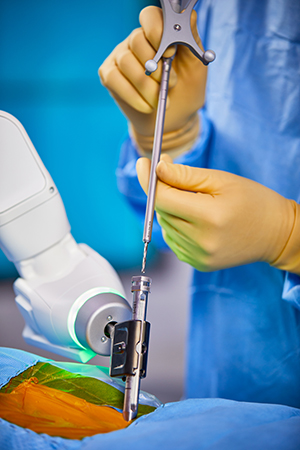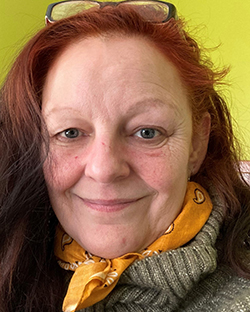
Stories
Spine patient meets robot: Improved Patient Outcomes Enabled with Technology
Clare Lane is one of the first Canadian patients to obtain robotic-assisted spinal surgery with the Medtronic Mazor X system at QEll Health Sciences Centre.
When unbearable back pain first landed Clare Lane in a Halifax emergency room in 2018, fate connected her with Dr. Sean Christie, the neurosurgeon on-call that night. What she didn't realize at the time was that this chance encounter would lead her to become one of the first patients in Canada to receive innovative personalized spinal surgery — with a robot.
An MRI had determined that a spinal disc was compressing one of Clare's key nerves, causing a condition known as foot drop. Dr. Christie was able to relieve her condition with conventional surgery, but 18 months later, the pain returned. And this time, more intensely.
By 2022, a new MRI indicated her spinal disc had re-herniated and pain medication was no longer helping. "I was barely functioning on opioids and nerve blocks, and I couldn't envision spending the rest of my life that way," she says. Clare met with Dr. Christie once again to discuss her options. This time, she was advised she was the perfect candidate for spinal fusion — a procedure that would include robotic-assisted surgery using the Medtronic Mazor™ X system.

Licensed by Health Canada in 2021, QE2 Health Sciences obtained one of the first Mazor X systems in Canada. Dr. Christie became an early adopter among Canadian specialists using robotic-assisted spine surgery in patients, completing the first case in Canada in July 2022. Dr. Christie credits the QE2 for its commitment to innovation, saying "Centers that are committed to bringing in technology demonstrate that they are centers that want to enable people to perform to the greatest of their capabilities."
The Mazor X system is designed to be used in procedures during general spinal surgery, minimally invasive, or percutaneous procedures. By combining robotics with navigation technology, surgeons can perform pre-operative planning, using real-time image guidance paired with interactive 3D modelling of patient anatomy, allowing for a more personalized approach for the patient.

When Clare entered the OR for the fusion procedure, she was met with a myriad of monitors and equipment. There was a perceptible buzz in the room and in the corner, the robotic arm. "I trusted Dr. Christie 100%," she said.
Currently, robotic-assisted surgery (RAS) is performed in only a small number of spinal procedures worldwide. This trend is projected to grow due to the precision and ability to pre-plan the procedures, reduce the number of revisions needed post-surgery and ultimately, enhance personalized care. Precision treatment can result in reduced post operative pain for patients, 1 and lower complication rates, 2 which in turn can lead to shorter length of stay (LoS) in hospital. 3 The goal for Mazor X System is to reduce variability through an accumulated global database of best practices.

Dr. Christie continues to field questions from colleagues and health system leaders who anticipate the technology could one day become a standard of care, and a means of attracting and retaining much-needed human resources. "People who are typically attracted to fields such as spine want to deliver the highest quality care that they can," says Dr. Christie. And the highest quality care arguably requires technology. “Because if you can do something well, you can do it better with technological assistance,” he adds. “I think centers committed to bringing in technology are attractive for the clinicians who want to continuously improve and ultimately deliver the best they can for their patients."
Patients like Clare, who now envisions visiting family long-distance and enjoying more quality of life. "I was on my feet at home a lot faster than I had ever imagined," she says of her surgery with Mazor. "If robotics can reduce the number of appointments needed after surgery, especially for an older patient, then I think, wow, it's just brilliant."
Learn more about Mazor in Canada
1 Schröder ML, Staartjes VE. Revisions for screw malposition and clinical outcomes after robot-guided lumbar fusion for spondylolisthesis. Neurosurg Focus. 2017 May;42(5):E12.
2 Hyun SJ, Kim KJ, Jahng TA, Kim HJ. Minimally invasive robotic versus open fluoroscopic-guided spinal instrumented fusions. Spine (Phila Pa 1976) 2017;42(6):353–8.
3 Fan Y, Du J, Zhang J, Liu S, Xue X, Huang Y, Zhang J, Hao D. Comparison of Accuracy of Pedicle Screw Insertion Among 4 Guided Technologies in Spine Surgery. Med Sci Monit. 2017 Dec 16;23:5960-5968.


